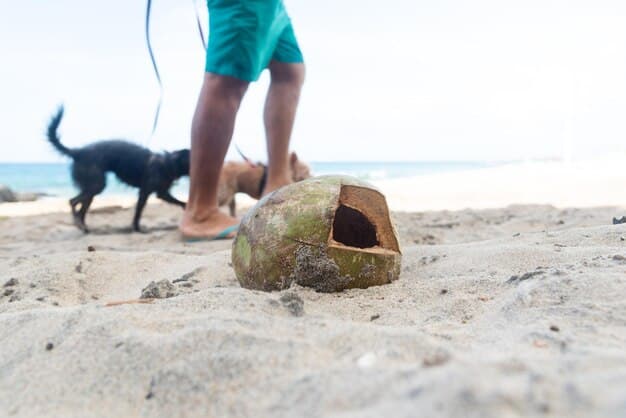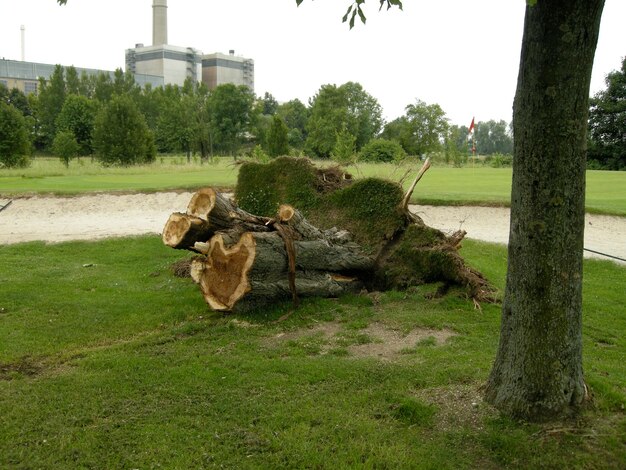Dig Pit Solution: Redirect Your Dog’s Digging Instincts

Anúncios
A designated dig pit offers a constructive outlet for a dog’s natural digging behavior, preventing destructive digging in unwanted areas and providing enrichment.
Does your furry friend have an undeniable urge to dig? Instead of scolding them, why not channel that energy positively? A digging dilemma: redirect your dog’s natural instincts with a designated dig pit is the perfect solution!
Anúncios
The Natural Instinct Behind the Digging Dilemma
Digging is an inherent behavior for many dog breeds. Understanding why dogs dig is key to addressing this behavior constructively rather than simply trying to suppress it.
Several factors can contribute to a dog’s digging habits. Recognizing these motivations allows pet owners to tailor solutions to their dog’s specific needs.
Understanding Why Dogs Dig
- Breed Predisposition: Some breeds, like terriers, are naturally inclined to dig due to their history of hunting burrowing animals.
- Boredom and Energy: Digging can be a way for dogs to expend pent-up energy and alleviate boredom, especially if they lack adequate exercise and mental stimulation.
- Comfort: Dogs may dig to create a cool spot in hot weather or a warm nest in cold weather, providing themselves with a comfortable environment.
- Anxiety and Stress: Digging can be a displacement behavior, indicating anxiety or stress. Identifying and addressing the underlying cause is crucial.
Ignoring the root causes of digging can lead to behavioral issues. A digging dilemma: redirect your dog’s natural instincts with a designated dig pit is a simple and effective solution.
Anúncios
Benefits of a Designated Dig Pit
Creating a designated dig pit offers numerous advantages for both the dog and the owner. It’s a win-win situation that satisfies the dog’s natural urges while protecting your yard.
A dig pit provides an appropriate outlet for a dog’s digging instinct. Here are some of the key benefits:

- Redirection of Destructive Behavior: By offering an approved digging zone, dogs are less likely to dig in gardens, flowerbeds, or other unwanted areas.
- Mental and Physical Stimulation: Digging engages a dog’s mind and body, providing exercise and preventing boredom.
- Reduced Anxiety and Stress: A dig pit can serve as a constructive outlet for stress, helping dogs feel more relaxed and content.
- Enrichment and Fun: A well-designed dig pit can be a source of endless fun and enrichment, keeping dogs entertained and happy.
Instead of constant frustration, a digging dilemma: redirect your dog’s natural instincts with a designated dig pit will provide a safe area for playing and digging.
Choosing the Right Dig Pit Location and Materials
Selecting the ideal location and materials for your dig pit is essential for its success. Consider factors such as accessibility, drainage, and the comfort of your dog.
A well-planned dig pit will be more appealing to your dog and easier to maintain. Here’s what to consider:
Location, Location, Location
- Accessibility: Place the dig pit in a location that is easily accessible for your dog, encouraging frequent use.
- Proximity to Supervised Areas: Choose a spot where you can supervise your dog while they dig, ensuring their safety and allowing you to reinforce positive behavior.
- Drainage: Ensure the location has good drainage to prevent the pit from becoming waterlogged, especially in rainy climates.
Selecting Safe and Engaging Materials
Select materials that are safe, comfortable, and appealing to your dog. Avoid anything that could pose a health hazard.
- Sand: Play sand or builder’s sand is a popular choice, providing a soft and easy-to-dig surface.
- Soil: Topsoil can be used but ensure it is free from fertilizers, pesticides, and sharp objects.
- Gravel: Pea gravel provides a different texture for digging and can offer a unique sensory experience for your dog.
The right location and materials transform a digging dilemma: redirect your dog’s natural instincts with a designated dig pit, making it the perfect spot for your companion.
DIY Dig Pit Construction: A Step-by-Step Guide
Building a dig pit can be a simple and rewarding DIY project. With a few basic materials and tools, you can create a fun and engaging space for your dog.
Follow these steps to build a dig pit that your dog will love:

- Choose a Location: Select a suitable location in your yard, considering accessibility and drainage.
- Gather Materials: Obtain materials such as wooden planks, plastic edging, or large containers, along with your chosen digging medium (sand, soil, or gravel).
- Build a Border: Create a border to contain the digging medium. This can be done by assembling wooden planks into a square or rectangle, using plastic edging to create a circular area, or repurposing a large container.
- Fill the Pit: Add the chosen digging medium to the pit, filling it to a comfortable depth for your dog to dig.
- Introduce Toys and Treats: Bury toys and treats in the dig pit to encourage your dog to explore and engage with the new area.
Building your own dig pit turns a digging dilemma: redirect your dog’s natural instincts with a designated dig pit and engages both you and your dog.
Training Your Dog to Use the Dig Pit
Introducing your dog to the dig pit requires patience and positive reinforcement. By guiding your dog and rewarding their behavior, you can establish the dig pit as a preferred digging spot.
Effective training techniques will help your dog embrace the dig pit. Here’s how to do it:
Introducing the Dig Pit
- Initial Exploration: Allow your dog to explore the dig pit at their own pace. Encourage them to sniff and interact with the area by tossing treats inside.
- Guided Digging: Gently guide your dog to dig in the pit using a toy or treat. Reward them with praise and positive reinforcement when they start digging.
Reinforcing Positive Behavior
- Consistent Rewards: Consistently reward your dog for digging in the pit, reinforcing the behavior you want to encourage.
- Redirection Techniques: If you catch your dog digging in an unwanted area, redirect them to the dig pit and reward them for digging there instead.
Introducing rewards will resolve a digging dilemma: redirect your dog’s natural instincts with a designated dig pit and reinforces a positive behavior.
Maintaining Your Dog’s Dig Pit
Regular maintenance is essential to keep your dog’s dig pit clean, safe, and engaging. Simple upkeep tasks will ensure the dig pit remains an attractive and enjoyable space.
Keep digging fun by regularly cleaning and replacing the materials in your dog’s dig pit:
- Regular Cleaning: Periodically remove debris, such as leaves, twigs, and any waste, to keep the dig pit clean.
- Material Refresh: Replenish or replace the digging medium as needed to maintain a comfortable and engaging surface.
- Toy Rotation: Rotate the toys and treats buried in the dig pit to keep your dog interested and stimulated.
Upkeep avoids the digging dilemma: redirect your dog’s natural instincts with a designated dig pit from becoming unpleasant and maintains an attractive, enjoyable space.
Addressing Common Digging Pit Problems
Even with a well-designed and maintained dig pit, some challenges may arise. Addressing these issues promptly can help ensure the dig pit remains effective.
Having issues? Here are the solutions:
- Lack of Interest: If your dog shows little interest in the dig pit, try adding more enticing toys or treats. You can also try mixing up the digging medium to make it more appealing.
- Digging Outside the Pit: If your dog continues to dig outside the pit, reinforce redirection techniques and ensure the dig pit is accessible and appealing.
Troubleshooting contributes to the digging dilemma: redirect your dog’s natural instincts with a designated dig pit by avoiding disinterest with continued reinforcement.
| Key Point | Brief Description |
|---|---|
| 🐾 Natural Instinct | Digging is often a breed-specific, natural behavior for dogs. |
| 🌳 Designated Dig Pit | Provides a constructive area to satisfy digging instincts. |
| 🏡 Location & Materials | Choose safe, accessible materials like sand or soil in a visible location. |
Frequently Asked Questions
▼
Dogs dig for various reasons, including breed predisposition, boredom, seeking comfort, or displacement behavior due to anxiety or stress. Identifying the reason can help tailor a solution.
▼
Safe materials include play sand, topsoil (free of chemicals), and pea gravel. Avoid anything sharp or toxic that could harm your dog. Ensure good drainage to prevent waterlogging.
▼
Introduce the dig pit gradually with toys and treats. Reward your dog with praise and positive reinforcement when they dig in the pit. Redirect them from digging in unwanted areas to the dig pit.
▼
Regular cleaning, such as removing debris and waste, should be done weekly. Replenish or replace the digging medium and rotate toys regularly to keep your dog interested.
▼
Try adding more enticing toys or treats and experiment with different digging mediums. Ensure the pit remains accessible and continue to reinforce positive digging behavior with rewards and praise.
Conclusion
A designated dig pit is an excellent solution to the digging dilemma: redirect your dog’s natural instincts with a designated dig pit in a constructive way. By understanding your dog’s digging motivations, providing a safe and engaging outlet, and reinforcing positive behavior, you can protect your yard while enriching your dog’s life.






